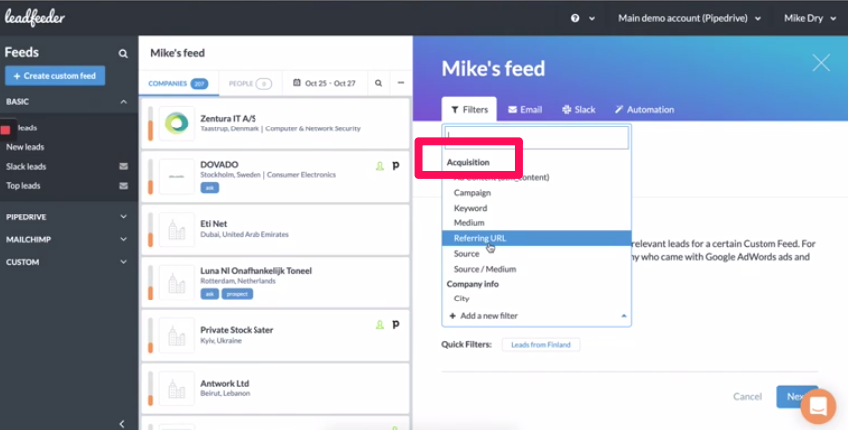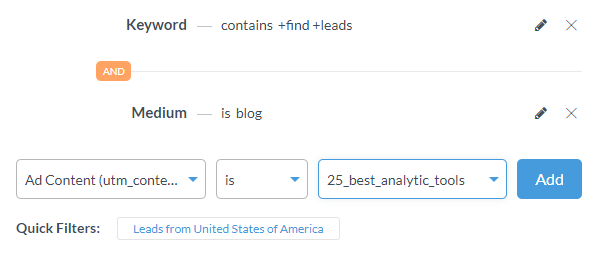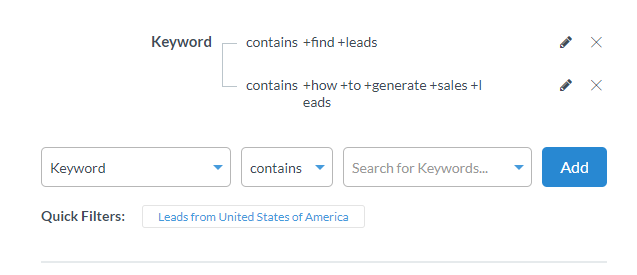Love data? Hate data? Confused by data? If you’ve used Google Analytics, there’s a good chance you’re familiar with their acquisition filters.
Leadfeeder's work in a similar way. But, Leadfeeder uses machine learning to filter ISPs and non-relevant hostnames out of your data.
Which, in my humble opinion, makes it far more useful.
Here's what you need to know about acquisition filters in Leadfeeder — and how you can use all that data take your B2B company from meh to killing it.
Note: Want to know where your leads are coming from? Try Leadfeeder's 14-day trial to learn how to better understand your buyer purchase intent data.
What are acquisition filters in Leadfeeder?
The acquisition filter is a fancy-pants term for a feature that lets you sort and filter traffic based on how traffic found your site -- or, you know, how you acquired them.
Clever name, right?
For example, these filters let you see which leads came to your sales funnel from a specific ad, so you can better understand how that campaign is #winning.
Or, you can view leads that come to your site directly by typing in your URL via the Referring URL filter.

Leadfeeder has a total of eight acquisition filters, including:
Ad content:Leads that have seen a specific ad
Campaign: leads that have followed a specific campaign
Keyword: Leads that used a specific key term
Referring URL: Leads that came in from a specific UTM parameter
Source: Filtered search that allows you to see leads from a specific source, such as those that came directly to your site source = "direct."
Medium: Leads from a specific category - for example, organic, CPC, or referral
Source/Medium: Combines both source and medium. For example, if you want to see organic search from Bing, you'd filter for: “Bing (source) / organic (medium)”
All these filters allow you to see the true effectiveness of your awesome marketing activities and the sources of traffic.
It can also tell you which leads then went on to fill out contact forms, made a phone call, or swiped right on your Tinder photo. (Okay, maybe not the last one.)
As a result, you can tell if what you are doing is actually resulting in the outcomes you'd hoped for, in terms of both quantity and quality.
How do you view acquisition filter data?
So we've covered what they are and why they matter. Now you want to actually do the thing.
Here's how to filter your acquisition data. Don't worry, you don't need to be a Google Analytics master to figure it out.
Login to Leadfeeder
-
Click "Create Custom Feed" in the upper left corner
![lead source custom feed]()
-
Select "Filters" in your feed.
![lead source filters]()
Name the filter, if you want to.
-
Scroll down to the dropbox below labeled "+Add a new filter"
![lead source new filter]()
-
Here you can see all the filters, including those for Behavior, Company Info, and CRM. But we are interested specifically in Acquisition Filter, so scroll down to see those.
![lead source ad content]()
Select the filter you want to use. For this example, we will select "Referring URL", which will show leads that found the site via a specific referring URL.
-
In the next drop-down menu, you can choose additional parameters, including contains, does not contain, is, is not, etc. We've selected contains and selected a specific URL, which is a specific Adweek article. This filter will display leads that were referred from that article.
![lead source referring url]()
Click "Add," and you will see all the leads that originated from this specific URL.
Remember, there are a total of eight different acquisition filters, so take the time to play around and understand how to use each one. You can set up a new feed for each filter, or combine the filters.
For example, you could Referring URL with location to see leads that originated from a guest post article and are located in your city.
What are the benefits of using acquisition filters?
Ready to slay your marketing?
Leadfeeder's acquisition filters give you access to data so you can make decisions about how the strategies you are currently using work —- and what might be more efficient.
But, there are a bunch of other benefits as well.
Budget-friendly
If you are already using Leadfeeder, this is data you already have, you don't have to add a new program or pay any additional fees. Woot!
As an added bonus, our software is more affordable than many of the larger analytic platforms.
Measure the efficiency of current campaigns
Say you've just implemented a brand new marketing campaign. Go you. But, how well is it actually working? The acquisition filters can tell you that.
For example, you can use the Ad Content filter to see if your most recent campaign killed it or crashed and burned.

Sure, you can see this data in Google Analytics.
But, Leadfeeeder takes it to a whole 'nother level.
For example, see leads that saw a certain ad and are also in a specific location and also searched for a specific key term, you can do that, too.

Highlight brand-spanking-new opportunities
In some cases, you might find you get a list of organizations you weren't trying to target.
Don't panic.
Take a deep breath and adjust your tactics.
For example, you might need to focus on different search engines or even different ad platforms — maybe you need to focus on Linkedin rather than Google to get high quality leads your heart desires.
Rock your customer's experience
In addition to helping you better understand where your customer's come from, you can use acquisition filters to smooth out their path to conversion.
If you look at Google CPC campaign, you can see if you are getting the right quality coming through, then you can look to see what path a specific organization took and look to see if it's an efficient journey.
If not, you can look for ways to turn that twisty turning path into a straight shot.
For example, if they are interested in a specific topic, which you can see based on the "key term" acquisition filter, you can send them a white paper you wrote about that very topic.
Final tip
Once you determine the most effective methods for acquiring new customers, make sure you work to retain those customers.
After all, you put a great deal of effort into targeting and nurturing those leads, don't let that work go to waste!
Plus, retaining customers is more cost-effective than constantly acquiring new customers.
Note: Want to know where your leads are coming from? Try Leadfeeder's 14-day trial to learn how to better understand your buyer purchase intent data.
More leads, no forms.
Sounds too good to be true? It’s not. Identify companies already visiting your website and turn them into qualified leads to fuel your sales pipeline.
Show me how











